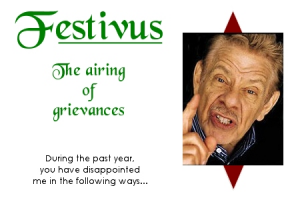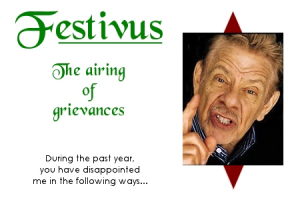Three Tips for Handling Complaints on Twitter
Nov 30, 2011 admin
The annual “Airing of Grievances” was made famous on Seinfeld, when the holiday Festivus was celebrated on December 23. The holiday requires those who observe it to reflect on the things that have disappointed them over the past year. But with the proliferation of social media, you don’t have to wait for an imaginary holiday to get your gripes off your chest. You can vent about your problems with airlines, restaurants, retailers or anyone, anytime, anywhere, in 140 characters. As consumers are increasingly empowered by social media, brands are faced with the new challenge of managing public complaints online. These constant complainers are the modern day equivalent of a tattletale. This is the person I want to label the “Tattle-Tweeter.”
We often provide tips about how to navigate the Twitterverse, and so, with a nod to Seinfeld, here are three tips for making sure you make the most of a bad Twitter mention:
Listen up. Recently, my husband Tattle-Tweeted about slow service at the Boston-based burrito chain Boloco. We were rushing to eat before a movie began in 20 minutes and were faced with an unusually backed-up service line. He tweeted: “Boloco = very slow Chipotle.” I told him he would have gotten a response if he used the appropriate handle when offering a critique of a brand. But almost immediately I was forced to eat my words because, even without the right handle, @bolocoCEO tweeted back a response!
John Pepper, who, in my humble opinion, totally gets what being a CEO is all about, asked where we were and for some additional details. The fact that the CEO cared and took the time to respond spoke volumes. As Tattle-Tweeters, we were slightly embarrassed for having complained when really, we were the ones in a rush. Before we even bit into our burritos, we were willing to give them the benefit of the doubt because we already felt like valued customers. The hubby even ended up tweeting a compliment after our movie. Moral of the story: Always be monitoring the conversations happening about your brand, even after traditional business hours. Monitor your handle but know the keywords to be looking for so you don’t miss an opportunity to elevate your brand. Have someone in your company (or someone like us @InkHousePR) monitor these channels all the time for you so you don’t miss the positive or negative things said about you.
You can’t hide. One thing brands that are effective on social media have in common is outstanding engagement. If someone Tattle-Tweets about you, the best way to show you care about thesatisfaction of all of your customers is by issuing a public tweet. Without retweeting any negative comments you should ask for more information by offering a telephone number. This immediately takes the conversation out of the public arena and behind closed doors, where customers are forced off their soapbox and into a valuable discussion with another human being.
Be real. There is a huge backlash/hatred in the social media savvy community about the use of auto-generated DMs. Think about your own experience with customer service departments. If you took the time to call a 1-800 number looking for help and all you got back was a voicemail telling
you how you are a “valuable customer” with no useful information, you would not be happy. It’s the same with Twitter. Take the time to ask your customer questions and make them feel valuable. This diffuses even the most hostile situation and creates a level of respect for your brand that may not have existed before the complaint.
Like most new social technologies, Twitter provides both opportunities and challenges for all of us. The best way to navigate these seemingly intimidating new media challenges is to stick to the principles that successful companies have always embraced: understand your customers and listen to them… no matter how many characters they are using to talk to you.
Just think, if @Frank_Costanza had been able to have his Tattle-Tweets answered all year long, there might not be “Festivus for the rest of us.” That might be a good thing. I was never good at the “Feats of Strength.”







